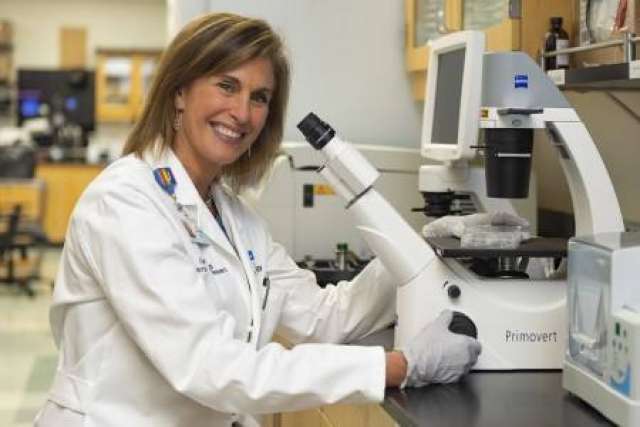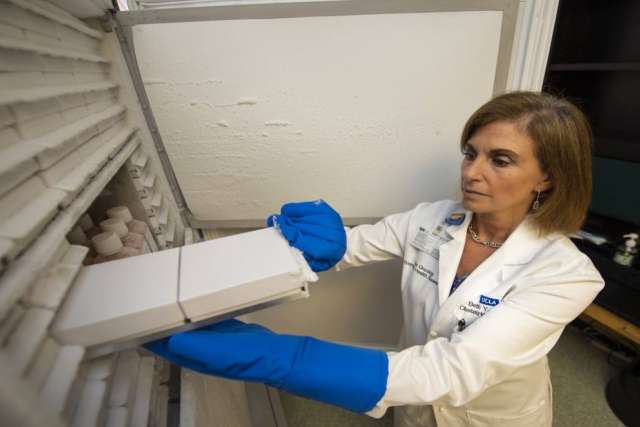UCLA Health’s Beth Karlan, MD, working with stem cell researcher Clive N. Svendsen, PhD, has developed what promises to be a game-changing approach in the treatment of ovarian cancer, a silent killer that often goes undetected until its final stages.
Ovarian cancer strikes almost two out of every 100 women. But for those who carry a mutated form of the BRCA1 gene, their risk of developing this most deadly of all gynecological diseases is 30 times higher than among the general population.
Gaining a better understanding of this hereditary genetic threat is one of the most pressing issues in gynecologic health. For that reason, it has become the life’s work of internationally renowned gynecological oncologist Dr. Karlan, a pioneer in her field and director of Cancer Population Genetics at the UCLA Jonsson Comprehensive Cancer Center.
Dr. Svendsen is the executive director of the Board of Governors Regenerative Medicine Institute at Cedars-Sinai Medical Center.
Dr. Karlan teamed up with Dr. Svendsen while she was leading Cedars-Sinai’s gynecologic oncology program, a position she held for nearly 30 years. In 2019, Dr. Karlan joined UCLA, where she also serves as a professor and vice-chair of Women’s Health Research in Obstetrics and Gynecology.

The doctors’ research, detailed in the Dec. 28 issue of Cell Reports, involves using blood cells donated from ovarian cancer patients with BRCA1 gene mutations to create organoids, lab-grown masses of cells that replicate an organ – in this case fallopian tubes, which is where most ovarian cancers originate. Their research not only suggests exciting new avenues of preventing ovarian cancer, but also opens the door to exploring new therapeutic interventions when it does develop.
Karlan said the establishment of fallopian tube organoids provides a model of human ovarian cancer that may help identify improved treatments and interventions.
Building on Nobel-winning science
To make this leap forward, Dr. Karlan and her colleagues are building on the research of Japanese physician Shinya Yamanaka, MD, who won a Nobel Prize for Medicine by demonstrating that common adult skin and blood cells can be reprogrammed to produce induced pluripotent stem cells (iPSCs).
"This explosion of new knowledge and technologies is pushing physicians and scientists to focus more on what we can learn from individual patients."
Dr. beth Karlan
Those cells can be transformed into any type of organ cells, such as those found in ovaries, or even into heart or brain cells. The technology gets around decades of political controversy over the use of embryonic stem cells by instead studying the induced pluripotent stem cells derived from an adult donor's skin or blood cells.
“Starting with white blood cells that were immortalized – manipulated to proliferate indefinitely – we made induced pluripotent stem cells, which can transform into any kind of cell for research,” Dr. Karlan said.
"Following years of intense study, the BRCA1 patient-derived iPSC were transformed into organoids that recapitulated the early cellular changes in ovarian cancer,” she said. "These organoids present a very promising model that we can now use to identify more effective treatments and prevention strategies. There are all kinds of exciting possibilities that we are already beginning to pursue. "
Using genetics to improve lives
Dr. Karlan, who is recognized worldwide for her work using genetics to predict and treat cancer, says new technology and discoveries allow doctors to improve women’s lives by helping to predict the likelihood that they will develop cancer and if they have cancer, to provide better ways for them to live longer.
This genetic information can allow personalized treatments to better effect the killing of cancer cells.
"This explosion of new knowledge and technologies is pushing physicians and scientists to focus more on what we can learn from individual patients,” Dr. Karlan said. “Applying our clinical observations in the lab allows us to begin to explain biologic behaviors, identify targets and develop new drugs that can be translated back into the clinic.”
She added: "We are working on taking the bedside research to the bench, and then hopefully bringing that knowledge back to the bedside to treat the patient – which is where this effort will hit pay dirt by saving lives.”
Decades of research
In addition to the scientific intrigue, the promise of this work is very close to Dr. Karlan's heart, as she has been treating cancer patients for more than three decades.
She has seen too many patients die as the medical profession has scrambled to find better treatments, she said. But trying to overcome these odds, some of her patients donated cells and tissue for research to help future patients to live longer.
“This new work provides us with a platform that we've never had before and a better model of human ovarian cancer," Dr. Karlan said. "This should enable us to more quickly and more specifically discover targeted ways to both prevent and treat ovarian cancer."
In the 1980s, early in her medical career, Dr. Karlan became interested in the way cancer cases seemed to cluster in families, indicating that the disease could be hereditary.
This prompted Dr. Karlan in 1989 to study the familial clustering of ovarian cancer. It wasn't until 1995 that scientists identified the BRCA1 and BRCA2 genes. They then found that mutations of these genes, which runs in some families, leads to a much greater risk of breast or ovarian cancer for women, as well as prostate cancer for men, and pancreatic cancer for both men and women.
"There are a lot of important questions still left to answer, such as why someone gets cancer. I’ve sat with sisters who all carry the same BRCA mutation, and one has breast cancer, one has ovarian cancer, and the other sister doesn’t have either cancer," Dr. Karlan said.
The developing technology should provide a better means of determining if someone with a family history of cancer will develop that cancer, by testing their cells in the lab, said Dr. Karlan, who was honored in 2021 with the Lifetime Achievement Award from the International Gynecologic Cancer Society.
Currently, the best means of cancer prevention in these cases is surgery, removing a women's ovaries and fallopian tubes where cancer cells are believed to originate.
"But our goal for the future is to find a way to flip a switch that can block a normal cell from becoming a malignant cell," Karlan said.
"That’s part of what’s so exciting about our organoid work right now," she said. "We are investigating whether we can use the model to find new ways to prevent cancer.”
Another dramatic opportunity that Dr. Karlan sees from the new technology is quicker identification of effective therapies for a specific patient with cancer, as doctors should be able to test drugs on a patient’s cells in the lab before ever putting those drugs into the patient's body.
"I think that it is a major advance. Using this platform that recapitulates human ovarian cancer that can be studied in a dish allows us to much more quickly screen drugs," Dr. Karlan said. "We can screen thousands of drugs to find the most effective treatment. We can have a much faster way to investigate therapeutic advances and even cancer prevention measures.”
Having put decades of work into helping women with cancer, Dr. Karlan is gratified to see real progress in the fight against this disease. While more questions and research remain, she is confident this work will translate into saving lives.
"This is where the excitement really begins," she said.
Tina Daunt is the author of this article.




